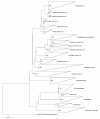High taxonomic level fingerprint of the human intestinal microbiota by ligase detection reaction--universal array approach
- PMID: 20398430
- PMCID: PMC2873488
- DOI: 10.1186/1471-2180-10-116
High taxonomic level fingerprint of the human intestinal microbiota by ligase detection reaction--universal array approach
Abstract
Background: Affecting the core functional microbiome, peculiar high level taxonomic unbalances of the human intestinal microbiota have been recently associated with specific diseases, such as obesity, inflammatory bowel diseases, and intestinal inflammation.
Results: In order to specifically monitor microbiota unbalances that impact human physiology, here we develop and validate an original DNA-microarray (HTF-Microbi.Array) for the high taxonomic level fingerprint of the human intestinal microbiota. Based on the Ligase Detection Reaction-Universal Array (LDR-UA) approach, the HTF-Microbi.Array enables specific detection and approximate relative quantification of 16S rRNAs from 30 phylogenetically related groups of the human intestinal microbiota. The HTF-Microbi.Array was used in a pilot study of the faecal microbiota of eight young adults. Cluster analysis revealed the good reproducibility of the high level taxonomic microbiota fingerprint obtained for each of the subject.
Conclusion: The HTF-Microbi.Array is a fast and sensitive tool for the high taxonomic level fingerprint of the human intestinal microbiota in terms of presence/absence of the principal groups. Moreover, analysis of the relative fluorescence intensity for each probe pair of our LDR-UA platform can provide estimation of the relative abundance of the microbial target groups within each samples. Focusing the phylogenetic resolution at division, order and cluster levels, the HTF-Microbi.Array is blind with respect to the inter-individual variability at the species level.
Figures




References
Publication types
MeSH terms
Substances
LinkOut - more resources
Full Text Sources
Other Literature Sources

